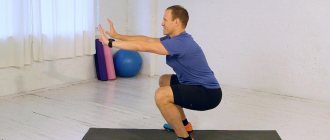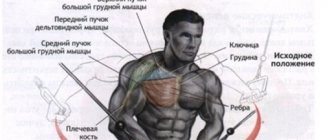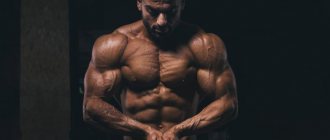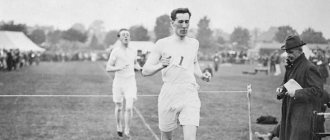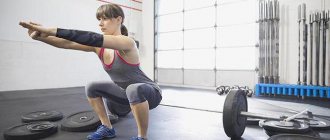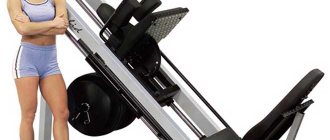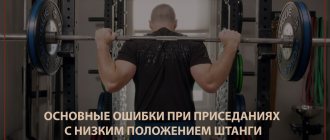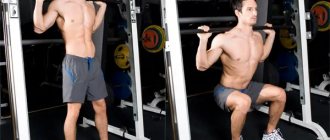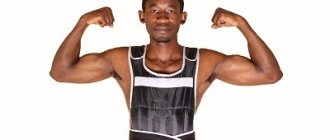Share:
What you need
- dumbbells
Every athlete or coach will agree that squats with dumbbells are a necessary exercise for gaining muscle mass. It is hardly possible to do without it. This is a basic multi-joint movement in which a huge number of muscle groups are directly or indirectly involved. And without a base there will be no growth.
You need to train your legs regularly, regardless of your sports goals. One workout per week will be enough. If it is physically and psychologically difficult for you to work out this entire muscle mass at one time, you can do quadriceps and hamstrings on different days. If you are gaining muscle mass, muscular legs will make your figure more proportional.
Moreover, heavy load on large muscle groups (and legs are such) promotes increased production of endogenous testosterone, which stimulates muscle growth and an increase in strength.
In this article we will look at how to do squats with dumbbells correctly, what are their benefits and what types of this exercise exist.
Benefits of Exercise
Let's start with what exactly the exercise is useful for athletes and what are its advantages over squats with a barbell.
- When working with dumbbells, it is easier for you to vary the angle of the load. For example, you can place your feet wide or narrow, place one foot on a bench, lift dumbbells above your head, etc. This way you can modify the load, shifting the emphasis to the quadriceps, buttocks, hamstrings or hip adductors. This is much more difficult to do with a barbell and requires experience and coordination.
- It will be easier for you to keep your back straight and squat deeper. This is the main advantage of squats with dumbbells for girls - the greater the amplitude, the more the gluteal muscles are involved, and this is the goal of most female athletes.
- The next important factor is mental attitude. Your brain perceives dumbbell squats as an easier exercise than barbell squats. Therefore, the body does not need any additional stimulation. If you are a fan of heavy training and squat almost record-breaking weights every week, vary your workouts. Do squats with dumbbells at least once a month. This way you will relieve your central nervous system a little from constantly working at the limit and protect yourself from overtraining.
- Another advantage of squats with dumbbells is that you can do them not only in the gym, but also at home. All you need is a pair of collapsible dumbbells. Do several sets of dumbbell squats with different leg positions, Bulgarian squats, lunges, straight-legged deadlifts, calf raises, and you’ll get a full-fledged volumetric leg workout.
Benefits of squats
Squats with dumbbells involve a huge number of stabilizer muscles. In this case, these are the deltoid and trapezius muscles, spinal extensors, core muscles, calf muscles, neck muscles, biceps and many others. Do you understand how much load you set with just one exercise?
In addition to stabilizer muscles, ligaments and tendons are also strengthened. You become stronger and more resilient with every workout.
Squats with dumbbells place less axial load on the spine. This does not mean that it is not there at all, and if you have hernias and protrusions, you can do them every workout. Not at all. Simply working with dumbbells in a gentle manner will not aggravate existing problems, unlike barbell squats.
In addition, working with dumbbells is much more mobile. You can place dumbbells on racks and immediately pick up a lighter or heavier pair. It is much more convenient to perform dropsets, supersets and giant sets. All of these techniques for increasing intensity contribute to greater overall results.
How to do a front squat?
The most important condition for performing any kind of exercise is not its aesthetic beauty, not the record weight you lift, but the correct technique.
In order to master squats with a barbell located on the chest, you need to gradually perform the following steps:
- Use a power rack. To do this, approach it and make the height of the racks convenient for you personally. The classic option is at the height of your own shoulders. Next, place the barbell on the racks and place the required number of weights.
- Step forward with one foot and tuck your shoulders under the bar. After crossing your arms, place them on the top area of the barbell. The location of the elbows must be strictly parallel to the floor. After removing the bar, take the reverse step.
- The initial position of the feet is shoulder-width apart, the toes turned 30-35 degrees. The abdominal muscles remain tense. This is the position from which the exercise starts.
- Before squatting, be sure to straighten your back and place your feet firmly on the floor. Next, slowly, while inhaling, begin squatting until your thighs are parallel to the floor. If you get a deep squat without compromising your technique, do it. The gaze is directed in the direction of movement.
- After pushing hard through your heels, straighten your legs and return to the starting position. Perform the specified sequence as many times as necessary.
Reading: How to pump up a girl’s buttocks?
How to pump up your butt? You can clearly see the flawless execution of the squat in this photo.
In addition to the classic version of the squat with a free weight in the form of a barbell, there may be the following options:
- Using dumbbells or weights. This is an excellent option for girls who are interested in adjusting their legs, rather than intensive mass gain, and beginners who are just mastering technique and a sense of balance.
- Using a Smith machine. The principle of performing the exercises is the same as with free weights. However, Smith squats provide additional control and safety.
Contraindications
Not all athletes will benefit from this exercise. If you have knee problems, you need to perform squats very carefully, work with light weights and strictly follow the correct technique. A thorough warm-up and use of knee bandages is also necessary. This applies not only to dumbbell squats, but also barbell squats, leg presses, lunges and other leg exercises.
It is not recommended to perform this exercise if you have problems with the spine. We are not talking about mild scoliosis or lordosis, but about serious hernias and protrusions in the thoracic or lumbar regions, when any forceful load is contraindicated. If such problems do not bother you, you can safely perform squats with dumbbells.
Single leg front squat
One of the best variations of barbell squats is the scissor squat and single-leg lunge.
To perform these exercises, good coordination of movements is required. It is not recommended to immediately move on to the barbell. It is best to start doing such exercises with dumbbells, or with minimal load on the body.
The difference between scissor squats and lunges is that when lunging, you need to take a step forward and maintain balance with a straight back.
When using the scissor squat technique, you need to stand as straight as possible, holding the barbell on your shoulders. You need to take a step forward, touching the floor with one knee. Next, pushing off with the heel of the front leg and the toe of the back leg, we take the starting position.
After each approach, you need to take a break so that your breathing is restored and you can begin a new set of exercises.
Squats to lunges are similar, the only difference is that you need to take a step forward and return to the original position.
Reading: Nutrition for gaining muscle mass
What muscles work?
Depending on where exactly you place the dumbbells, what incline you hold, how wide you place your legs, and how you place your feet, you can focus the load on the quadriceps, glutes, hamstrings, or hip adductors.
For example, when doing plie squats with a dumbbell, we spread our legs wider than shoulder-width apart and turn our feet outward, and keep our body strictly vertical. This loads the inner thigh and buttocks, part of the load is taken by the quadriceps. It's the same story with wide squats with dumbbells. Such a load makes the hips larger. The inner surface of the thigh responds well to load in almost all athletes; with the outer surface, everything is much more complicated, and few even experienced athletes can boast of its development.
To develop the outer quadriceps, close-legged squats, overhead dumbbell squats, or single-leg dumbbell squats are more suitable. It is important to place your feet parallel to each other to further contract the lateral quadriceps muscle.
You can also shift the load specifically to the gluteal muscles. Bulgarian squats with dumbbells are best suited for this. The load falls almost exclusively on the buttocks; if you lean forward a little more, the hamstrings will also begin to work. The greater the amplitude in these movements, the better. Deep squats with dumbbells are great for girls.
General principles of the exercise
Next we will talk about several variations of the exercise, but before moving on to a description of the technique of each type, we should mention the general principles of correct squats with dumbbells.
- Working out the inner thighs is facilitated by wide stance of the legs and turning the toes outward (more than 45 degrees).
- Working out the gluteal muscles is facilitated by the maximum possible range of motion (below the level of parallel with the floor).
- Working out the outer thigh is facilitated by a narrow and parallel stance of the legs.
- Working out the hamstrings is facilitated by a slight bend forward and moving the buttocks back during movement.
Types of squats with dumbbells
Let's look at several of the most effective types of squats with dumbbells.
Plie squats with dumbbells
Plie squats with dumbbells - to perform effectively, you need to hold it with both hands in front of you at waist level. Instead of a dumbbell, you can also use a kettlebell or a barbell disc. The main thing in this exercise is to maintain the correct body position.
- The dumbbell should not weigh you down or tilt you down.
- We place our feet wider than our shoulders, turn our toes outward, the angle is approximately 60 degrees.
- Keep your back strictly vertical.
It is advisable to place your feet on step platforms; this will increase the range of movement by a few precious centimeters, and you will be able to go lower. Due to this, the buttocks and hip adductors will work harder. You need to lower yourself down until you touch the back of your thigh to your calf muscles. The pace of the exercise is smooth; no sudden movements should be made. It is important to feel the stretching and contraction of the muscles at each point of the amplitude.
Bulgarian squats
The next popular leg exercise that can be performed with dumbbells is Bulgarian squats. To perform them you will need a horizontal bench. We place one foot on the bench with the toe down, and bring the other forward. The distance between the legs should not be too large; the front leg should be slightly bent at the knee. Squat down smoothly on your front leg. Anatomically, the movement is similar to lunges. The farther you place the front leg, the more the gluteal muscles work; the closer, the more the load is emphasized on the quadriceps. Beginner fitness enthusiasts are advised to adhere to a certain “golden mean”: put one leg forward so that the knee remains slightly bent, and there are still a few centimeters between the knee and the foot.
If you want to additionally “hook” the inner surface of the thigh, do not place your front leg straight, but slightly turn your toe outward. The exercise should be done with moderate weight; in no case should you round the thoracic spine when lowering down. The amplitude here may be somewhat shortened. Often athletes work in a static-dynamic mode, without going all the way down and without straightening the knee at the top point. This way, the necessary muscle group will be under constant tension, and even light dumbbells will be enough to create sufficient prerequisites for muscle growth.
Squats with dumbbells on shoulders
Squats with dumbbells on the shoulders almost completely imitate classic squats with a barbell. The load vector falls in exactly the same way. The only difference is that there is no need to statically tense almost all the muscles of the torso, as with heavy squats with a barbell. Just position the dumbbells so that you are comfortable without them weighing you down. Keep your back as straight as possible so as not to place stress on the spinal extensors.
© artinspiring — stock.adobe.com
Another option for holding dumbbells on your shoulders:
© dusanpetkovic1 — stock.adobe.com
Deep squats with dumbbells in hands
You can load the quadriceps in isolation by performing deep squats with dumbbells in your hands. The easiest way to do this is to use one dumbbell or kettlebell and hold it in front of you at chest level. The result will be an almost complete imitation of front squats with a barbell. This exercise is often called goblet squats.
Here it is advisable to use a relatively narrow parallel position of the legs. Place your feet slightly narrower than shoulder-width apart so that you can comfortably perform the exercise with a decent weight and you can fully focus on contracting your quadriceps. At the bottom point, you can take a short pause, completely extinguish the inertia and rise upward in an explosive manner. This training method develops explosive strength and speed of movement well. In the same style, you can perform squats with dumbbells in your hands, keeping your arms straight along your body. This exercise is good for developing neuromuscular communication and teaches you better control of the stabilizer muscles, which will be useful for you on record weights in barbell squats.
Single leg dumbbell squats
For experienced athletes, squats with dumbbells on one leg are also good. This exercise requires not only strength, but also tremendous coordination and balance. It should be performed at a slow pace and with light working weights. Of course, before this you need to learn how to consistently perform pistol squats without additional weight, or at least with the help of TRX loops or other support.
© Makatserchyk — stock.adobe.com
Overhead dumbbell squats
CrossFit athletes can take note of an exercise such as overhead squats with dumbbells. It is not much different from overhead squats with a barbell in terms of biomechanics, but psychologically it is much easier. These exercises are needed in order to increase your results in basic weightlifting movements: snatch, clean and jerk, clean and others. Here you can give yourself free rein and work with heavy weights, but remember that the correct technique for performing the exercise is above all.
© Arsenii — stock.adobe.com
Alternatively, you can perform this variation of the movement with two dumbbells:
Scissor squats with dumbbells
Dumbbell scissor squats are a variation of lunges. They are especially popular among girls. They are done in exactly the same way as Bulgarian squats, only without using a bench. To increase the range of movement, you can place one or two step platforms under your front leg. This way you can go down as low as possible and fully bend your front leg at the knee joint. This way the quadriceps will do more work than when performing movements at half the amplitude.
Scissor lunges are a variation of squats for strong quads and glutes.
One of the most popular lunge variations is the standing or scissor lunge. They are used in training programs for both men and women, regardless of their goals. Using scissors, you can form voluminous quadriceps, or tighten your hips and create a beautiful shape for the gluteal muscles.
What muscles work in scissor squats?
Two main muscle groups are heavily affected:
- quadriceps femoris (rectus, vastus lateralis, vastus medialis, vastus intermedius);
- as well as the gluteus maximus and gluteus medius muscles.
During the execution, the tensor fascia lata is activated.
Features of the exercise
The great advantage of the exercise is its versatility; scissor lunges are recommended for everyone, during the period of muscle gain or cutting, when working on endurance. The exercise is a basic one; it can be performed either with free weights or in a Smith machine.
pros
- A universal exercise - suitable for men and women at any time of training.
- A multi-joint exercise that simultaneously trains several muscle groups - quadriceps and buttocks.
- Accelerates metabolism, improves both the anabolic effect on the body as a whole, and promotes the burning of subcutaneous fat under certain loads.
- Stretches muscles, allowing muscles to recover faster after strength exercises.
Minuses
- If the technique is incorrect, the knee joint may shift forward, which can cause meniscus loss.
- Balance skills are required as poor balance can lead to falls and injury.
Technique for performing lunges in place
Important! Before performing lunges, you need to warm up and stretch your muscles well!
- Stand straight, place your palms on your waist.
- Take a long step forward, placing your front foot completely on the floor and your back foot on your toes.
- As you inhale, slowly lower yourself into a squat, keeping your back knee off the floor and your front knee off your toe. The thigh is lowered until it is parallel to the floor, the knee and heel remain in the same plane.
- Do not lower your body forward, do not rotate your pelvis.
- As you exhale, lift your pelvis more quickly, keeping the entire body support on the heel of your front foot. Concentrate on strengthening your glutes.
- Perform the exercise first on the right leg, then on the left leg. Keep your balance.
- Having received a load on both legs, rest for 1 minute and proceed to the second approach.
You can make the exercise more difficult using a platform. The supporting (front) leg stands on the platform, the second - the toe on the floor. The technique of movement remains the same, do not rush to return the foot from the hill, keep your balance.
Scissor lunges with dumbbells
- Take dumbbells, lower and relax your arms, holding the dumbbells on the sides of your hips.
- Place your right foot forward, lunge to one side, then switch.
- Follow the same technique for performing the exercise as with the version without weight ↑.
Scissor lunges with pancakes
- Take one plate (depending on the required load weight) in both hands, keep your palms on the sides of the projectile. Bend your elbows and hold the plate at chest level, maintaining this position for the entire approach.
- As in the previous version, perform it on one leg, then on the other leg.
- After performing, straighten your elbows and lower the plate to the floor or bench.
Lunges with a barbell
- Place the barbell on your shoulders, take it from the floor or from the racks, observing safety precautions, tighten the weights with special locks. Hold the barbell with a wide grip.
- Take a careful step forward with your right foot, maintain balance, start with light weights.
- Perform an approach on the right, then on the left leg.
- Once completed, place your feet together and remove the barbell from your shoulders.
Smith Scissor Lunge
As with the barbell option, perform lunges in the machine, placing the bar on your shoulders - remove it from the racks, turning it with your palms, and remove the locks. Place one foot forward and the other back on your toes. Keep your knee at a right angle. With the help of a simulator, maintaining balance is much easier. Do the same amount on both legs. Scissor lunges in Smith photo
Conclusion
The scissor technique is not so simple, sometimes it requires mastering without any equipment. Beginners can perform lunges with their own weight, or using an elevated platform. Girls should master the technique with light weight; the wider the distance between the feet, the more the gluteal muscle works and stretches. Men can work with a narrower foot stance to increase stress on the quadriceps.
Basic exercise technique
So, we briefly examined the main types of squats with dumbbells. The same technical principles apply to all of them:
- We use moderate weight dumbbells. Do you want to set records? Place them in barbell squats. We need squats with dumbbells in order to relieve the psyche a little from heavy weights, diversify the training process and give the muscles an unusual load to which they are not yet adapted. Also, many powerlifters use them as an aid to classic squats, and this bears fruit.
- In all exercises you need to keep your back straight. Rounding the spine is unacceptable; this can result in serious injury. At the starting point, stand straight, look forward or slightly upward (this will make it easier for you to get up from the lowest point). We bring the chest forward and up. The downward movement is carried out while inhaling, it is advisable to do it slowly to feel how the muscles stretch.
- Squats should be deep. It is advisable to squat below parallel. Ideally, your buttocks almost reach the floor. This requires good coordination and flexibility. Additionally, hone these skills, then any exercise will be much easier.
- At the lowest point, the knee should not go forward beyond the level of the toe. This is the golden rule of any type of squat.
- The positive phase of the amplitude passes approximately twice as fast as the negative one. We always get up while exhaling. If you do not follow the correct breathing sequence, by the end of the set your blood pressure will rise, and it will take at least a couple of minutes to regain your breathing.
- The most important thing when standing up is to keep your knee in the correct position. It should be located in the same plane as the foot. Do not wrap it inward under any circumstances; it is very easy to injure the knee ligaments this way. A slight outward movement of the knee is acceptable, but it is better not to do this either, as this will make it more difficult for you to concentrate on the work of the leg muscles.
- The pause at the top should not be too long. Firstly, the axial load on the spine at this moment is maximum. Secondly, when you just stand straight with your knees straight, the muscles are in a relaxed state. Pumping is much more difficult to achieve this way. It is advisable not to pause at the top point at all or not to fully extend the knee in order to maintain constant tension in the muscles.
- If you perform squats with dumbbells with straight arms, use wrist straps if necessary. This will take your mind off the grip and allow you to fully focus on your quadriceps.
- Always warm up and stretch thoroughly before performing dumbbell squats. This way you are guaranteed to protect yourself from injury.
Common mistakes and recommendations
Those who are just starting to use front squats in their training often make the same mistakes:
- They look not straight ahead, but up or down, which often leads to loss of balance;
- Hold your back unevenly;
- They reduce the amplitude of movement, most often not descending completely;
- They use too much weight, as a result of which the bar simply falls out of the hands.
Recommendations:
- Perform a front squat in front of a mirror or have someone watch your technique;
- Pay attention to the position of your legs and back, as well as the direction of your gaze;
- At the top point, leave your knees slightly bent, since their full extension removes the load from the leg muscles and transfers it to the knee joints, which can subsequently lead to injuries or diseases of the joints;
- Don't chase the scales. Front squats have a number of technical features, so you are unlikely to be able to immediately squat with the same weights as with the classic version of this exercise.
Front squats can take your leg training to the next level. They are especially relevant for those whose legs are a lagging muscle group, as well as for people who have recently recovered from back injuries, especially the lumbar region.

